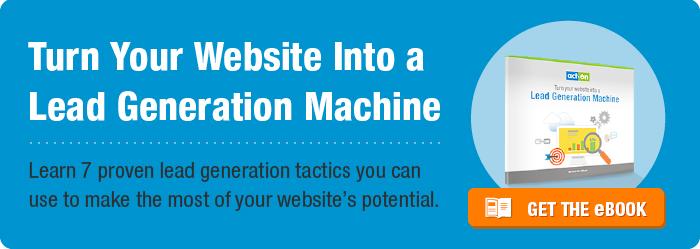Jim Obermayer is the host of the Sales Lead Management Radio Program, which goes out to over 8,000 worldwide members of the Sales Lead Management Association (SLMA). Recently, he interviewed Janelle Johnson, director of demand generation at Act-On, about the art of turning website visitors into leads. This blog post is an edited transcript of their conversation. You can listen to the podcast on SLMA radio.
 JIM: Janelle, welcome to SLMA radio.
JIM: Janelle, welcome to SLMA radio.
JANELLE: Thank you. I’m so thrilled to be here today, and I’m excited about this topic.
JIM: Well you’ve got the expertise to talk to the subject. So: when you get people to the website, how do you convert them? Say there are three, four or five thousand people hitting the website a month, and five people fill out forms or respond. What’s a marketing manager to do?
JANELLE: When I look back earlier in my career, the website was really just a branding exercise. As times have changed, and as the buyer’s journey has shifted, people are doing more research online before making a purchase decision. Your website still represents your brand and who you are as a company, but it also needs to inform and educate buyers and help provide the sales team with insight into what these buyers are looking for. You want to make sure that you understand who your audience is, and make sure that you’re providing content that fits their needs.
JIM: I see a lot of people get carried away with the education portion and making it too hard for someone to contact you. It’s buried someplace, or they can’t find the phone number. Marketers seem to say, “Well if they really want us, they’ll find out how to reach us. We’re there to educate.” But you’re spending all this money and nobody’s contacting you. What is someone to do? How do they go from education to forms and contact and making this thing pay?
JANELLE: That’s a very key point. Because you can throw a party, but you want to know who’s going to come. You want that invite list. It’s the same thing with your website. Some key things to do are to make sure that you’re providing very easy ways to get in touch with you, like contact forms. Make sure that they’re prominent across all pages. Make sure that they’re easy to find. But then you want to also do testing, because button colors – or the copy on those buttons – can make a huge difference.
We have an on-demand demo on our site, and we were chugging along, getting pretty good numbers of people requesting the on-demand demo. We went through and looked at the top 10 performing pages on our website in terms of traffic. We tested different button copy. Very slight copy changes drove 3X improvement in the people filling out the form to watch our on-demand demo.
JIM: So your first tip is to test the copy that’s used to request people to inquire. It isn’t just get a free white paper, which is not an inquiry, it’s just a way to get their name.
JANELLE: Right. So instead of saying, “learn more,” you can test and see if you say, “watch on demand demo now” if it will make a difference. Using different words, testing that button copy, will make a difference in your response rate. It’s also where that button is on the page. As you mentioned before, sometimes it’s buried at the bottom. Bring it up. If you’re looking at a responsive page and it’s mobile, you don’t want somebody to have to scroll down on their phone to find that button. Bring it up to the top. Maybe put it in multiple places throughout the page so that when somebody’s interested, it’s easy for them to get there.
JIM: Sometimes web directors get offended when I say I’d like to put a request for information button up. Some just get really offended by the whole thing.
JANELLE: That’s because there’s so many people that care deeply about your company website. It’s filling a lot of different needs. So you might have a web director who wants a beautiful site, and wants to make it very streamlined and clean. And oftentimes what works with direct response is maybe less beautiful, but very easy to understand how to take the next step. At every company I’ve been with, there’s been a little bit of a discussion of what that should actually look like. Sometimes these discussions are rather heated.
One of the things that I’ll throw out there is, “You know what? We’re not the end user, let’s put it to a test, let’s see what happens, let’s do an A/B test on this, and serve it up.” Let the data show what’s working.
JIM: Do an A/B test, serve it up. So you typically let the end user vote on what the best response is. What are some of the best offers that seem to get people to respond on these websites?
JANELLE: Well, we talked about the on-demand demo. We used to do weekly live product demos. What’s interesting is that it worked a lot better a few years ago. But today, people are used to seeing something right now. On-demand videos work very well. Something that somebody can look at, understand what it is, and quickly make a decision as to if they want more information, and what their next step is.
We also get good responses with more interactive tools, like an ROI calculator, where people can put in their own data, interact with the form, and then see exactly how this is going to impact their efforts.
JIM: We’ve got some ROI calculators on the SLMA site to predict the value of a lead generation program. They seem to work quite well. So you’ve got the interactive calculators, you’ve got the look-and-understand content, and the on-demand video. You say things have moved from the weekly demo, we’re going to have a demo every week at 10:00 in the morning, why don’t you join us, to on-demand. So it’s the immediate need.
In one of his books consultant Andy Paul talks about how customers want information immediately. They don’t want proposals in a week. They want answers right now, same day. And you’re confirming it here. What other advice can you give people to push up that demand on their sites and to start getting the responses? It’s mainly qualified leads. It’s easy to get people to respond to a white paper, but they’re not qualified leads.
Address leads by their stage in the funnel
 JANELLE: Yes, but it’s a first step. You need to be able to look at it by funnel stages, and how you are getting people to engage in the top of the funnel so you can capture their information. Maybe they’re just interested in a white paper. And maybe that’s not a buying signal. But it is somebody who’s interested in that topic. You want to be able to nurture them further so that when they are ready, you’re top of mind. So white papers and content offers like that are great for the top of funnel as you’re pulling people in, making sure that you’re addressing the needs that they have, as they’re learning about a topic or researching it. Then you can nurture them further with relevant emails based on what they were looking at.
JANELLE: Yes, but it’s a first step. You need to be able to look at it by funnel stages, and how you are getting people to engage in the top of the funnel so you can capture their information. Maybe they’re just interested in a white paper. And maybe that’s not a buying signal. But it is somebody who’s interested in that topic. You want to be able to nurture them further so that when they are ready, you’re top of mind. So white papers and content offers like that are great for the top of funnel as you’re pulling people in, making sure that you’re addressing the needs that they have, as they’re learning about a topic or researching it. Then you can nurture them further with relevant emails based on what they were looking at.
Then for middle of funnel, you might want to look at how other people solved this problem with case studies or testimonials. Then we talked about some of the later, bottom of funnel things with the on-demand demo, ROI calculators, and free trials. Some companies get good results by giving people an opportunity to test drive the product.
JIM: I like the way you divided those things very neatly into the three stages in the funnel. I keep learning new things. And that is such a good, common sense way to look at things. Can you think of any other tips, and can you give us any case studies of how this has worked with yourself or other people?
JANELLE: Absolutely. One of the things we talked about is that a website fits a lot of different needs for different people. We also talked about the different funnel stages. One of the nice things about having all types of funnel stage content, the top, middle, and bottom of funnel content available on your website, is you can truly see where somebody is, what they’re interested in as they’re interacting with the content on your site.
This is key for both marketing, and sales. Because if somebody is on your site and they’re downloading a very top-of-funnel white paper, that’s different than somebody who’s come into your site looking at the on-demand demo, using an ROI calculator, and looking at the pricing page. That signals buying behavior. And that activity needs to be made available to a sales rep so that they know that these are two different people with very different needs. One of them is a hotter prospect that they need to address in a different way. So making sure that you’re tracking what types of activities and behaviors happen on your site, and making sure that that information is available to your sales team is key.
You asked for a case study. We have an SEO audit tool. You fill out a form and let us know what keywords you want to rank – keywords you want to optimize your site for. The tool analyzes the page and comes back with a score and some tips and tricks to help you improve your score. Now, we created this as a lead gen piece, and initially we thought that it was a top-of-funnel piece. So we put it on our site and we tested it to some of our lists at the top of the funnel. And it didn’t perform as well as we expected. We weren’t sure why. So we tested different copy on the buttons, and tested different layouts.
But we had an SEO eBook on a very similar topic. It’s one of our top-performing offers for top-of-funnel. So we did a test, side by side, of those two against each other. The audit, which is specific to your website, versus the eBook, which is general information about website optimization. It was interesting because the eBook performed much better in top of funnel. But the audit performed a lot better in middle and bottom of the funnel. So it helped us to then identify which types of content we should be targeting and to better identify the buyer persona: what they’re interested in, what types of actions they’re taking at various buyer stages.
JIM: It makes so much sense. Now one of the things I find that’s different – this is not a commercial for Act-On, but you are a good example here. You actually provide pricing on your site. And not everybody does that.
JANELLE: It’s interesting because people will decide to not move forward if they don’t know at least the price range. And if people are looking to get a feel for the pricing – that’s a good buying signal. As a matter of fact, we talk about how to optimize your website and make sure that you’re capturing those leads. Another thing that we’re looking at is how to rank those prospects. So we’re scoring different pages on the website differently based on if it’s a buying-signal page or not. And so that pricing page is key for us, because people who go to that page are more likely to buy. We want to make sure that anybody who hits that pricing page gets scored appropriately, and that the sales team knows that information.
JIM: Very interesting. Tell us a little bit more about your software in the last few minutes. Your software itself, does that also do the scoring?
JANELLE: It does, yes. It also does email marketing and automated programs, so as people fill out forms you can then put them into an automated nurture campaign based on their interests. It really takes a lot of the manual process of marketing out of it, because you’ve got a path that they take. You can look at existing customers to see what they did before. And you can build those automated programs and messaging to allow people to enter themselves into that.
Then, when their score increases or when their engagement increases, then you’re looking at that via the activity history and the lead scoring. How many videos have they watched? Have they done the on-demand demo? We want to make sure that those leads are ranked properly, and that the information is available to the sales team in their CRM. All of the lists and segments are done within Act-On, but it syncs with the CRM. So the sales team has insight into what behaviors somebody is taking on the website.
JIM: When you get new customers, do you help train their sales forces on this whole new process?
JANELLE: Absolutely. Every customer has an assigned customer success manager, and they’re with you for life. They’re going to make sure that your company is very successful. Let’s say you have a new batch of sales reps coming on board and you want to train them on the tool. Because it’s a shift not only for the marketer, but for the sales team as well.
I remember years ago in various other marketing roles, I would be generating leads that would come through an Excel spreadsheet. And that’s what the sales team had to call on. But they didn’t know if that person had just been on the website. They didn’t know that they had also seen the on-demand demo or downloaded a white paper. All they knew was that this was a name on a spreadsheet. This dramatically changes what the sales team has insight into, and affects how they can manage their leads and prioritize their time.
JIM: Janelle, you’ve given us a great list of things to do, to get better response, not just to get people to the site, but to actually turn website visitors into leads. Thank you very much.
JANELLE: Thank you so much for having me.
SLMA Radio is broadcast by the Sales Lead Management Association through the internet, live, on Thursdays, at 10am PST. Listeners can connect via the SLMA website. Recorded versions of the SLMA Radio program can be found on the SLMA website, via iTunes, on many of the interviewees’ websites, and via the many syndicated outlets carrying the entire programming list of shows.
Looking for more tips and tricks on how to generate more leads from your website? Download Act-On’s free eBook, Turn Your Website into a Lead Generation Machine. 
